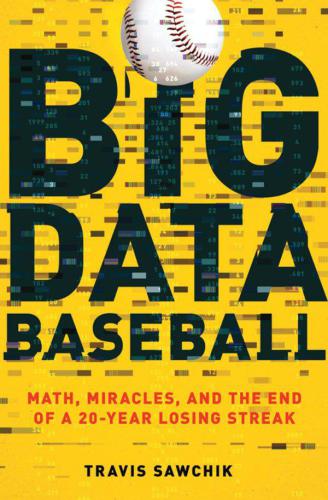
Big Data Baseball
Math, Miracles, and the End of a 20-Year Losing Streak
کتاب های مرتبط
- اطلاعات
- نقد و بررسی
- دیدگاه کاربران
نقد و بررسی

April 13, 2015
The Pittsburgh Pirates are among a handful of Major League Baseball teams to wholly embrace emerging big-data analytics in order to build rosters and win games. This enlightening book by Sawchik, the Pirates beat writer for the Pittsburgh Tribune-Review, explains how the team helped redefine the game by hiring information technologists to track and interpret millions of data points on everything from pitch speed to batted balls during the 2013–14 season. Data-tracking systems such as PITCHf/x and TrackMan—tools that measure the entire flight of a baseball—allowed the Pirates’ staff of young analysts (most of whom had no professional baseball experience) to become integral to the team’s first winning season in two decades. Old-school manager Clinto Hurdle and his aging coaching staff learned to trust the data more than their guts, and convinced skeptical players to employ an unconventional infield shift—something few teams did on a regular basis despite vast analytical evidence supporting it. Taking cues from Michael Lewis’s Moneyball and Jonah Keri’s The Extra 2% (books that explore how other small-market, low-payroll MLB teams use metrics), Sawchik wonderfully dissects statistics and the game itself in a style that will score with a broad range of readers.

April 15, 2015
Pittsburgh Tribune-Review writer Sawchik debuts with a celebration of the Pirates' recent return to glory with the help of some computer all-stars. As the author notes in his subtitle, the Pirates had been pathetic for more than two decades. But their resurrection began, he writes, when manager Clint Hurdle, who was in danger of losing his job in 2013 after two disappointing seasons, decided to embrace "big data"-the vast amounts of information becoming available about everything from the positioning of infielders to the grips that pitchers use on their fastballs. Sawchik employs several techniques throughout, giving the back stories of the various principals in the drama, clearly explaining the technological advances in the game (Money Ball and beyond), recording the strategies and successes that management employed and enjoyed. We hear about Hurdle, pitcher Francisco Liriano, and catcher Russell Martin. But it's not just the players. Computer whiz Dan Fox, for example, also gets his due. The story advances as the team-more or less willingly-accepts the necessity of listening to what the data are whispering. Shift infielders from their traditional positions, get pitchers who induce grounders from the hitters, find catchers who "frame" pitches for the umpires, measure the specific skills of outfielders-these and other topics fill most of the text, along with a few accounts of specific moments in games and some playoff game summaries. Sawchik, of course, is a "homer," so he rarely describes any mutinous mumblings aboard the Pirate ship. At times, the story reads almost like a John R. Tunis baseball book for boys (The Kid from Tomkinsville, etc.): Tunis' optimism, idealization of character, and overall enthusiasm all are here. Most important is Sawchik's realization, however, that the diamond will never again be so rough-data-gatherers and -analysts are polishing assiduously. Both a comprehensive and a focused look at how computer-recorded data are fundamentally altering America's pastime.
COPYRIGHT(2015) Kirkus Reviews, ALL RIGHTS RESERVED.

June 15, 2015
This promising debut by Pittsburgh Tribune-Review baseball beat writer Sawchik reveals how the small-market, tiny-budget Pittsburgh Pirates ended a string of 20 straight losing seasons and made an improbable return to the playoffs in 2013 by blending old-and new-school methods of roster building and on-field strategizing. Sawchik mines similar territory to Michael Lewis's best-selling Moneyball, but here there's less personal and intraorganization drama and deeper explorations into how data-based decisions impacted particular games. And whereas the Oakland A's of Moneyball fame primarily relied on number crunching to improve their offense, the Pirates mixed the objective, quantitative findings of their newly hired, forward-thinking group of software engineers and data analysts with traditional scouting and player evaluations to shore up their defense. Manager Clint Hurdle used computerized, granular data analytics to help with free-agent signings, defensive positioning, and pitch selection and location. The author additionally draws on interviews with forward-thinking Hurdle and various Pirates players, coaches, and staff members to provide enthralling backstories of both the data providers and those who used the information during games. VERDICT Casual and hard-core baseball fans alike who enjoyed Moneyball are sure to be entertained and informed by this sort-of sequel.--Douglas King, Univ. of South Carolina Lib., Columbia
Copyright 2015 Library Journal, LLC Used with permission.

Starred review from May 1, 2015
If sabermetrics was most famously used by Billy Beane's Oakland A's to fortify an underfunded offense, the equally impoverished Pittsburgh Pirates used that science in 2013 to end the longest losing streak in pro-sports history20 seasonsby upgrading their defense. The team made three critical discoveries: some catchers are uncanny at earning strike calls (and thus outs . . . and wins) for their pitchers, traditional infield alignments hardly reflect where a ground ball will likely be hit, and the addition of one pitchthe two-seam fastballto an entire staff's arsenal can induce grounders, and thus outs, to a shifted infield. And so they picked up free-agent catcher Russell Martin at a discount, reset the infielders in unorthodox but deadly precise positions, and got pitcher buy-in on the slower but more effective two-seam fastball. How this motley collection of menfrom data geeks to throwback coaches to reluctant playersworked the numbers together to mold a winner makes Sawchik's tale as compelling as Michael Lewis' Moneyball (2003). Which is saying a lot.(Reprinted with permission of Booklist, copyright 2015, American Library Association.)

























دیدگاه کاربران